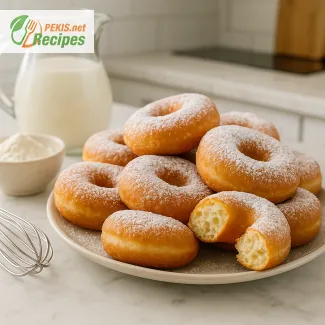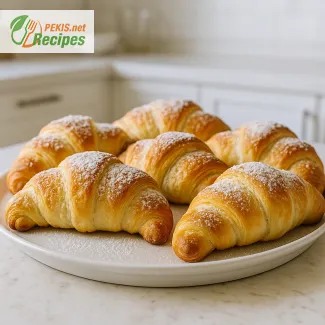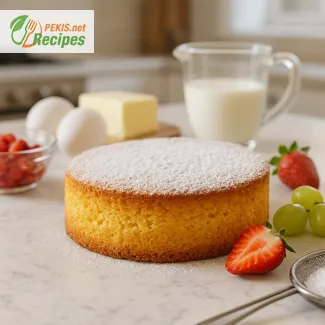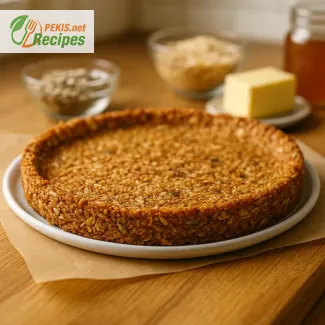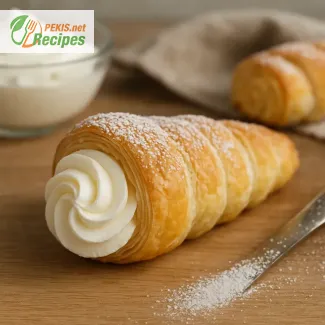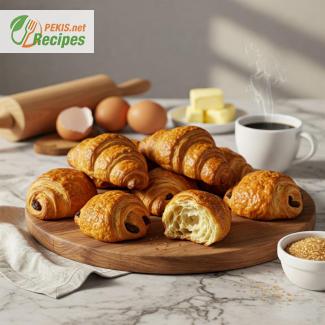
The Ultimate Guide to Crafting the Perfect Pastry
A Timeless Delight for Every Occasion
There’s something truly magical about the perfect pastry—its crisp, flaky layers giving way to a soft, buttery interior that melts in your mouth. Whether enjoyed as a morning indulgence, a delightful afternoon treat, or the highlight of a festive gathering, homemade pastries have a way of bringing people together. The secret to a truly unforgettable pastry lies in the balance of texture, flavor, and technique—and with the right recipe, you can recreate that bakery-quality perfection in your own kitchen.
The Secret to a Flaky, Buttery Pastry
The hallmark of any great pastry is its flakiness. Achieving that perfect texture requires attention to detail, from choosing the right ingredients to mastering the technique of incorporating butter into the dough. The key lies in using high-quality butter, ensuring it remains cold, and folding the dough just right to create those signature layers.
Another important element is flour selection. The type of flour used can significantly impact the pastry’s texture, with a balance between protein content and gluten development playing a crucial role. A touch of sugar and salt enhances the flavor, while a splash of cold water helps bring everything together without overworking the dough.
Why This Pastry Recipe Stands Out
There are countless pastry recipes out there, but what makes this one truly special is its versatility. Whether you prefer a sweet or savory filling, this dough provides the perfect foundation. It’s light, airy, and crisp, making it an excellent choice for everything from fruit-filled delights to cheese-infused wonders.
Another reason why this recipe is a favorite among baking enthusiasts is its foolproof method. Even if you’re new to pastry-making, following a few simple steps ensures consistent results every time. With minimal effort, you can achieve that perfect golden-brown crust and an interior that’s as soft as a cloud.
Essential Techniques for the Perfect Pastry
Keeping It Cold
One of the biggest mistakes home bakers make is working with warm butter. Keeping the butter and other ingredients chilled ensures the dough retains its flakiness. A quick tip: chilling the dough before rolling it out prevents shrinkage and helps achieve a beautifully structured pastry.
The Folding Method
Laminating the dough—folding and rolling it multiple times—creates those delicate, airy layers that make pastries so irresistible. This process might seem intimidating at first, but once you get the hang of it, you’ll notice the difference in both texture and taste.
Resting Time
Patience is key when it comes to baking exceptional pastries. Allowing the dough to rest gives the gluten time to relax, resulting in a tender and perfectly textured pastry. This step is crucial for avoiding a tough or dense final product.
Pastries for Every Mood and Occasion
One of the best things about homemade pastry is its incredible versatility. You can fill it with seasonal fruits, rich custards, or decadent chocolate, or keep it simple with a light dusting of powdered sugar. For savory lovers, adding cheese, herbs, or even a touch of spice can elevate the pastry to a whole new level.
No matter the occasion, whether it’s a casual weekend brunch, a celebratory feast, or simply an evening treat, this recipe ensures you’ll always have something special to serve.
Why Homemade Is Always Better
While store-bought pastries are convenient, nothing compares to the taste and freshness of a homemade creation. When you make it yourself, you control the quality of ingredients, ensuring there are no unnecessary preservatives or artificial flavors. Plus, the satisfaction of baking from scratch adds a whole new level of enjoyment to the experience.
Mastering this classic pastry recipe will not only elevate your baking skills but also bring joy to those who have the pleasure of indulging in your creations. Once you try it, you’ll understand why this is the most loved pastry recipe in the community.
- Prepare the dough: In a large mixing bowl, combine flour, sugar, and salt. Add the cold butter, cut into small cubes. Use your fingers or a pastry cutter to mix until the mixture resembles coarse crumbs.
- Add water: Gradually pour in the cold water, stirring gently until the dough starts to come together. Be careful not to overwork it.
- Chill the dough: Shape the dough into a disk, wrap it in plastic wrap, and refrigerate for at least 30 minutes.
- Roll out the dough: On a lightly floured surface, roll out the dough to about 3 mm (⅛ inch) thick.
- Shape the pastry: Cut the dough into desired shapes or line a pastry tin. If making filled pastries, add your preferred filling at this stage.
- Brush with egg yolk: Beat the egg yolk and brush it over the pastry for a golden finish.
- Bake: Preheat the oven to 180°C (350°F). Bake for 20-25 minutes or until golden brown.
- Cool and serve: Let the pastries cool before serving for the best texture.
Mastering the Art of Pastry Perfection
Small Changes That Make a Big Difference
A well-made pastry is an experience—flaky, buttery, and irresistibly light. But even the best recipes can be refined to enhance flavor, texture, and versatility. Whether you're looking to create a richer taste, achieve a healthier version, or prevent common baking pitfalls, making small adjustments to ingredients and technique can take your pastry-making skills to the next level.
Choosing the Right Butter for the Ultimate Texture
Butter is the heart of any classic pastry. Using high-quality, unsalted butter with a higher fat content (such as European-style butter) results in a more tender and flaky texture. Standard butter contains more water, which can create steam and interfere with the layering process.
For an extra deep, nutty flavor, try browning the butter before incorporating it into the dough. This small adjustment enhances the richness of the pastry while still preserving its delicate nature.
The Secret Ingredient: Vinegar or Lemon Juice
A trick many professional bakers use is adding a teaspoon of vinegar or lemon juice to the dough. The acidity helps prevent gluten overdevelopment, ensuring that the pastry remains soft and flaky rather than tough and chewy. This method is particularly useful for beginners who may unknowingly overwork the dough.
Why Homemade Pastry Is Always Better
Store-bought pastry may be convenient, but it often contains preservatives, artificial flavors, and lower-quality fats that compromise taste and texture. When you make it yourself, you control the ingredients and freshness, ensuring a superior end result. Homemade pastry also allows for customization, letting you experiment with different flours, fats, and fillings to suit your preferences.
Avoiding Common Mistakes That Ruin Pastries
Overworking the Dough
One of the biggest mistakes when making pastry is kneading or mixing the dough too much. Overworking it causes too much gluten to develop, making the final product tough instead of delicate. The best approach is to handle the dough as little as possible, just until it comes together.
Using Warm Ingredients
Keeping everything cold is key. Butter should be chilled, and even the flour and mixing bowl can be refrigerated before starting. Warm butter melts too quickly, preventing those essential flaky layers from forming.
Rolling Too Thin or Too Thick
A pastry that is too thin will become brittle and dry, while one that is too thick may not cook evenly. Aim for about 3 mm (⅛ inch) thickness for the perfect balance of crispness and tenderness.
Healthier Alternatives Without Losing Flavor
For those looking for a lighter version, there are several ways to tweak the recipe while keeping the indulgent taste intact.
- Substituting some of the butter with Greek yogurt or coconut oil reduces saturated fat while maintaining a soft texture.
- Using whole wheat or spelt flour instead of white flour adds fiber and nutrients, though a blend of whole wheat and all-purpose flour is best to maintain a light consistency.
- Reducing the sugar slightly does not significantly impact the structure of the pastry, especially if you're filling it with naturally sweet ingredients like fruit.
- Adding ground nuts or seeds (such as almond flour or flaxseeds) provides healthy fats and proteins, making the pastry more nutrient-dense.
Enhancing Flavor with Creative Additions
Incorporating Spices and Herbs
Pastry doesn't have to be plain—a pinch of cinnamon, nutmeg, or cardamom can add warmth and depth to a sweet version, while thyme, rosemary, or even black pepper can elevate a savory one.
Using Alternative Liquids
Instead of water, try using milk, buttermilk, or even fruit juice for added richness and complexity. Buttermilk adds a slightly tangy note, while fruit juice subtly enhances sweet pastries with natural sugars.
The Role of Resting Time
Letting the dough rest in the refrigerator is crucial. Not only does this allow the butter to firm up, but it also relaxes the gluten, preventing shrinkage during baking. For best results, chilling for at least 30 minutes to an hour is recommended, though overnight chilling can lead to even better flavor development.
The Perfect Baking Conditions
Baking pastries at the right temperature makes all the difference. An oven that is too cool can result in a pale, undercooked pastry, while one that is too hot can cause excessive browning before the layers properly develop. A steady 180°C (350°F) to 200°C (400°F) is ideal for most pastries.
Placing the tray in the middle of the oven ensures even heat distribution, while using parchment paper prevents sticking and promotes even browning.
Perfecting a traditional pastry recipe is all about understanding the science behind the ingredients and techniques. By making small but strategic improvements, you can elevate the taste, texture, and nutritional value of your pastry while keeping its irresistible charm intact. Whether you’re baking for a special occasion or simply indulging in a homemade treat, these refinements will ensure every bite is as delightful as possible.
- Contains gluten (flour) and dairy (butter).
- May contain egg if using an egg wash.
Substitutions for Allergies & Gluten-Free Option:
- Replace all-purpose flour with gluten-free flour mix.
- Substitute butter with plant-based margarine for a dairy-free version.
- Use a plant-based milk wash instead of egg yolk for a vegan-friendly option.
- Vitamin A: Supports vision and immune function.
- Vitamin B12: Aids in nerve function and energy metabolism.
- Calcium: Essential for bone health.
- Iron: Helps transport oxygen in the blood.
- Vitamin E: Protects cells from oxidative damage.
- Selenium: Supports immune health and reduces inflammation.
- Polyphenols: Present in whole grains, help fight free radicals.
